For most vegetable ferments, you'll want to use between 2% to 5% salt by weight, with 2.2% to 2.5% being the sweet spot for common vegetables like cabbage, carrots, and radishes. You'll need more salt (3-4%) for water-rich vegetables like cucumbers to maintain crispness, while drier vegetables can use less. Always use non-iodized salt without anti-caking agents, as these additives can inhibit beneficial bacteria growth. A digital scale helps you measure precisely, preventing under-salting (which risks spoilage) or over-salting (which slows fermentation). Understanding the nuances of salt ratios will transform your fermentation success.
Understanding Salt in Fermentation
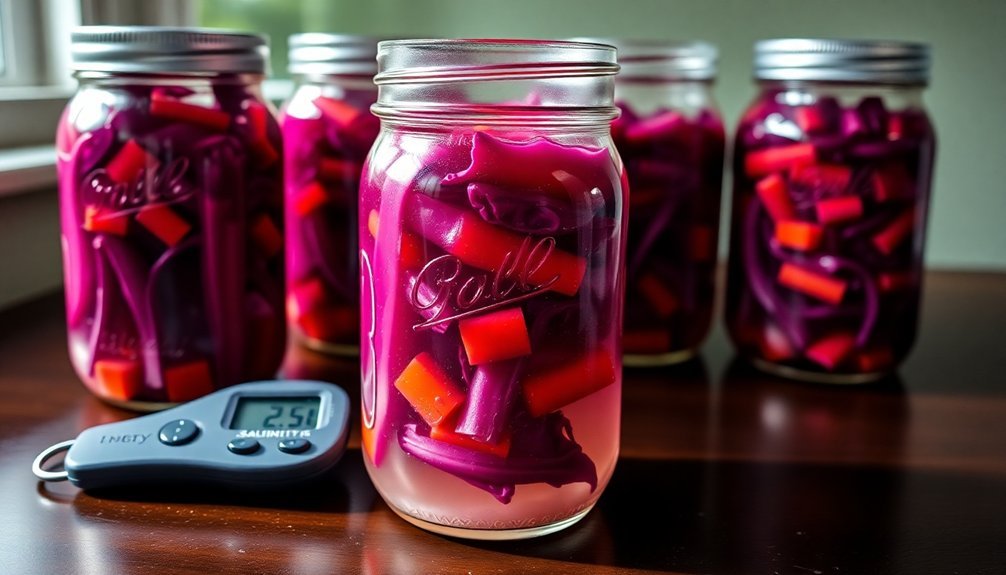
In the world of fermented vegetables, salt plays a vital role that goes far beyond simple seasoning. When you're fermenting vegetables, salt acts as a powerful selective agent, creating an environment where harmful bacteria can't thrive while beneficial lactic acid bacteria flourish. Salt also helps maintain crunchy texture by slowing down enzymatic activity in the vegetables. This selective process is essential for successful fermentation and guarantees your vegetables will be both safe and delicious.
You'll find that salt's influence on the fermentation process is multifaceted. It helps maintain an acidic environment that's perfect for beneficial bacteria to do their work, while simultaneously preventing the growth of pathogenic microorganisms that could spoil your ferment.
When you add the right amount of salt, you're effectively creating a natural preservation system that's been used for thousands of years.
The magic happens as salt draws water from the vegetables to create a nutrient-rich brine. This brine becomes the perfect medium for beneficial bacteria to multiply and convert sugars into lactic acid.
Basic Salt Percentage Guidelines
You'll find that starting with 2% salt by weight provides a safe foundation for most vegetable ferments, especially common ones like cabbage, carrots, and garlic.
This percentage gives you enough salt to prevent harmful bacteria while allowing beneficial bacteria to thrive and create that signature fermented flavor.
Avoid using salt with anti-caking agents or additives, as these can interfere with the natural fermentation process.
If you're fermenting cucumbers, squash, or hot peppers, you'll want to increase your salt percentage to 3-4% to maintain better crunch and preservation.
Starting With Safe Ranges
Starting your fermentation journey with the right salt concentration is crucial for both safety and success. You'll want to begin with the tried-and-true 2% salt ratio for most vegetables, including cabbage, carrots, garlic, and celery. This percentage creates an ideal environment where beneficial bacteria thrive while harmful ones can't survive. Traditional fermented foods like sauerkraut and kimchi maintain this 2% salt level for optimal results.
For cucumbers, hot peppers, and squash, you'll need to increase the salt content to 3-4%. These vegetables require extra salt to maintain their crunch and guarantee proper preservation.
If you're working with olives or umeboshi plums, you'll need to use a much higher concentration of around 10%.
You can calculate your salt percentage using either weight or volume measurements. For weight-based calculations, simply multiply your vegetable weight by the desired percentage. For example, if you're fermenting 1 kg of cabbage at 2%, you'll need 20 grams of salt.
When making a brine, you can use 1-3 tablespoons of salt per quart of water. Remember that using too little salt risks spoilage, while too much can halt fermentation completely.
Understanding Salt's Preserving Power
Salt's preserving power lies at the heart of successful fermentation, working as both a natural safeguard and flavor enhancer. When you add salt to your vegetables, it creates an environment where harmful bacteria can't thrive, while beneficial lactic acid bacteria flourish. This selective process is vital for safe fermentation and guarantees your vegetables develop the right flavors and textures.
The salt concentration you choose directly affects how your fermented vegetables will turn out. Higher salt levels (above 5%) will slow down fermentation and help maintain crunchier vegetables, but they might eventually halt the fermentation process. Lower concentrations speed up fermentation but increase the risk of unwanted bacteria growth.
Salt's preserving action works through osmosis, drawing water from the vegetables to create a protective brine. This natural brine submerges your vegetables, creating the oxygen-free environment needed for proper fermentation.
You'll notice the brine forms quickly, which is critical as it feeds the beneficial bacteria while preventing mold growth. The salt also slows down the enzymes that would otherwise make your vegetables go soft, helping maintain that desirable crunch you're looking for.
Salt Types for Fermentation
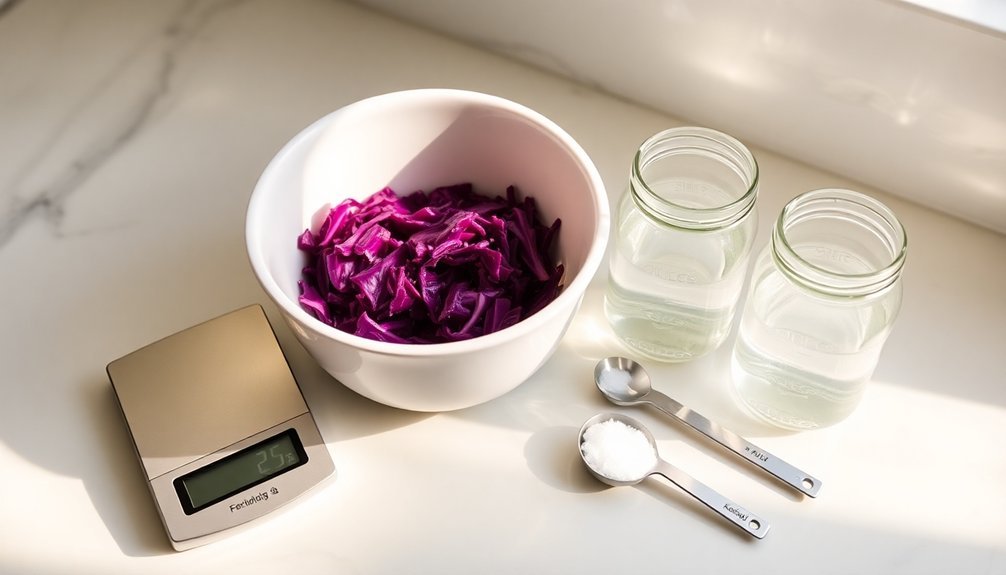
When choosing salt for fermentation, it's crucial to select the right type to guarantee success. You'll want to focus on natural, unrefined salts that don't contain additives or anti-caking agents. Sea salt and Himalayan salt are your best options, as they're rich in minerals and completely pure.
Celtic sea salt is particularly popular among fermenters, while Himalayan salt's pink hue indicates its mineral content.
Pickling salt and kosher salt can work for fermentation, but you'll need to check their labels carefully. While pickling salt is refined and lacks the mineral benefits of natural salts, it's free from additives and dissolves easily.
Kosher salt may contain anti-caking agents, so verify the ingredients before use.
You should strictly avoid iodized table salt and any salts containing additives, as these can interfere with the fermentation process and affect your final product's taste.
The iodine in table salt can inhibit beneficial bacteria growth, while anti-caking agents can create off-flavors. For best results, stick to pure, unrefined salts with "salt" as the only ingredient listed.
Calculating the Perfect Brine
Now that you've selected the right salt, calculating the ideal brine concentration becomes your next key step. For optimal fermentation and food safety, you'll want to aim for a salt percentage between 2% and 5%, with 2.2% to 2.5% being the sweet spot for most vegetables.
To calculate your brine, you'll need to weigh both your vegetables and water together using a digital scale. Don't forget that vegetables are mostly water (93-98%), which factors into your total weight.
First, tare your scale with an empty container. Then add your vegetables and water, noting the total weight. Multiply this weight by your desired salt percentage to determine how much salt you'll need. For example, if your total weight is 1000 grams and you're using 2.5%, you'll need 25 grams of salt.
For a simpler approach using volume measurements, add about 20 grams (4 teaspoons) of salt per liter of water for a 2% brine. Remember to dissolve the salt completely in your water before adding it to your vegetables, ensuring they're fully submerged to minimize air contact.
Dry Salting Method Ratios

When you're using the dry salting method for vegetable fermentation, you'll need to apply salt directly to your chopped or shredded vegetables at a ratio of 1.5% to 2% of their total weight.
You can easily calculate the amount of salt needed by multiplying your vegetable weight in grams by 0.02 (for 2%) – for example, 1000g of cabbage would require 20g of salt.
The salt ratio you choose may need adjustment based on your vegetables' moisture content and environmental conditions, with drier vegetables or humid climates potentially requiring slightly more salt to achieve proper fermentation.
Direct Salt Application Method
The direct salt application method, also known as dry salting, offers the most straightforward approach to fermenting vegetables at home.
You'll find this technique particularly effective for finely chopped or grated vegetables, as well as those that naturally contain high water content.
To get started, you'll need to use 1.5% to 2% salt by weight of your total ingredients. If you're fermenting during warmer months or want crunchier results, opt for the full 2%.
Mix the salt directly with your prepared vegetables in a nonreactive bowl, then massage them for 10-15 minutes to release their natural juices.
You'll know you're on the right track when the vegetables create enough liquid to submerge themselves.
Pack everything tightly into your fermentation jar, making sure to eliminate air pockets. Add a weight to keep the vegetables below their brine – this is essential for successful fermentation as it minimizes oxygen exposure.
Don't use antibacterial soap when handling your ingredients, and keep your fermentation environment clean.
If you notice your vegetables becoming too soft or fermenting too quickly, you may need to adjust your salt percentage in future batches.
Calculating Vegetable Salt Ratios
Building on the direct salt application method, exact salt calculations can make or break your fermentation project. For successful fermentation, you'll need to use weight-based measurements, typically ranging from 1.5% to 2% of your total vegetable weight. This means if you're fermenting 1000g of cabbage, you'll need 20g of salt for a 2% ratio.
| Vegetable Type | Recommended Salt % |
|---|---|
| Cabbage/Carrots | 2% |
| Cucumbers/Squash | 3-4% |
| Olives/Fruits | Up to 10% |
When calculating your ratios, always weigh your vegetables first, then multiply that weight by the desired percentage (convert to decimal form). For example: 1000g × 0.02 = 20g salt. Lower percentages (1-2%) will give you faster fermentation, while higher percentages (up to 3%) help maintain crunchiness and prevent mold growth.
Remember that different vegetables require different salt concentrations based on their water content and preservation needs. While cabbage-based ferments like sauerkraut work well with 2% salt, cucumbers might need 3-4% for ideal results. Always use a exact scale for accurate measurements to guarantee consistent results.
Dryness Vs Salt Amount
During dry salting, maintaining the right balance between vegetable moisture and salt content is essential for successful fermentation. When you're working with high-water content vegetables, you'll need less salt compared to drier varieties. The standard range of 1.5% to 2% salt works well for most vegetables, but you'll need to adjust based on their natural moisture levels.
Summer vegetables, which tend to be less water-dense, might require either additional water or slight adjustments to your salt percentages. You'll want to guarantee there's enough liquid to create a proper brine for fermentation.
When using the dry salting method, consider these key factors:
- Finely chopped or grated vegetables release more water, requiring less additional brine.
- Using 2% salt creates crunchier vegetables and better mold resistance.
- A 1.5% salt ratio promotes faster fermentation but may reduce shelf life.
- Cucumbers and squash need 3-4% salt due to their unique composition.
If your vegetables aren't producing enough brine after the initial 10-30 minute soaking period, you can add dechlorinated water to guarantee proper coverage.
Remember to pack your vegetables tightly to minimize oxygen exposure and promote successful fermentation.
Vegetable-Specific Salt Requirements
Different vegetables require specific salt concentrations for successful fermentation, ranging from 1.5% to 10% depending on their water content, texture, and preservation needs.
For basic vegetable fermentation, you'll want to start with a 2% salt concentration, which creates an ideal environment for beneficial bacteria while preventing harmful microorganisms.
When fermenting cabbage for sauerkraut, stick to 1.5-2.5% salt concentration – you'll find that the salt naturally draws out the vegetable's juices when you knead it into the shredded leaves.
Root vegetables like carrots, beets, and radishes need a slightly higher salt concentration of 2-2.5%. You can achieve this by using 20 grams of salt per kilogram of vegetables.
For more delicate and water-rich vegetables like cucumbers and summer squash, you'll need to increase the salt concentration to 3% and use a brine solution of 3-5% to prevent mold growth effectively.
Some vegetables require even higher salt concentrations – peppers do well with 3-4% brine, while specialty items like olives and umeboshi plums need a much higher 10% salt concentration for proper preservation.
Risks of Incorrect Salt Usage
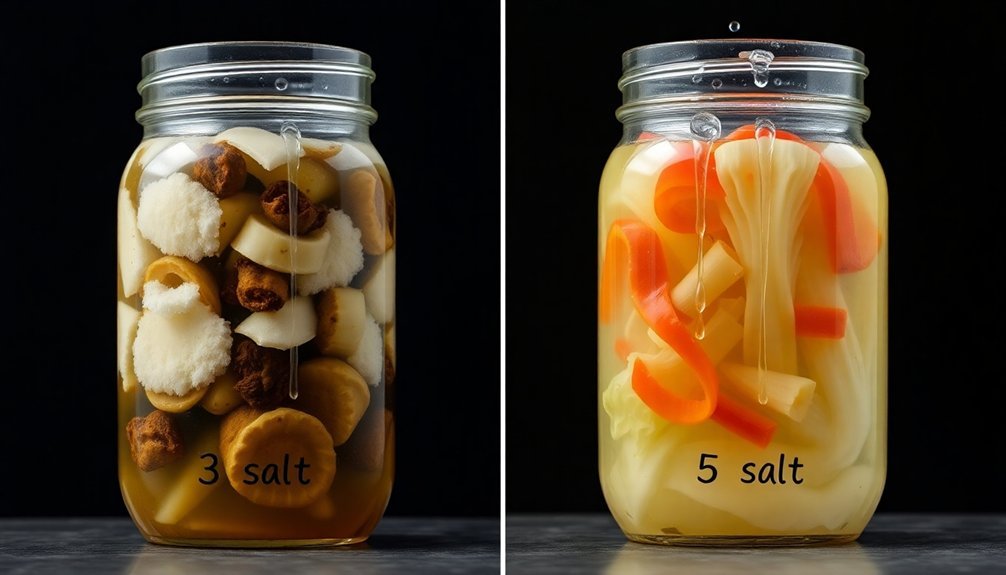
The correct salt concentration serves as a foundation for successful fermentation, but getting it wrong can lead to serious problems. When you use too little salt, you're inviting unwanted bacteria and mold growth, which can spoil your ferments and create unsafe conditions.
Conversely, excessive salt can slow or completely halt the fermentation process by inhibiting the beneficial bacteria you're trying to cultivate.
Both extremes can greatly impact your fermented vegetables' texture and flavor. Too little salt results in soft, mushy vegetables, while too much salt, though maintaining crunchiness, can stall flavor development and make your ferments unpalatably salty.
Consider these vital risks when determining salt concentration:
- Insufficient salt allows harmful microorganisms to thrive, potentially making your ferments unsafe to consume.
- Excess salt inhibits beneficial bacteria, preventing proper fermentation and flavor development.
- Poor texture control leads to either mushy vegetables (low salt) or overly firm products (high salt).
- Health implications range from increased food safety risks with too little salt to excessive sodium intake with too much.
Maintaining proper salt levels isn't just about taste – it's essential for both safety and successful fermentation outcomes.
Salt's Role in Preservation
Salt's many preservation mechanisms work together to create the perfect environment for fermentation. When you add salt to vegetables, it immediately begins extracting water from them, creating a nutrient-rich brine that's fundamental for the fermentation process.
This brine not only submerges the vegetables, preventing oxygen exposure, but also creates an ideal anaerobic environment for beneficial bacteria like Leuconostoc and Lactobacillus to thrive.
You'll find that salt plays a significant role in controlling the fermentation rate by maintaining an optimal acidic environment. At concentrations between 2% to 5%, salt effectively suppresses unwanted bacterial growth while allowing beneficial microorganisms to flourish.
It's also instrumental in preserving the texture of your fermented vegetables by slowing down enzymatic activity that would otherwise cause softening.
The preservation power of salt extends beyond microbial control. It helps maintain the vegetables' crunchiness by inhibiting cell wall breakdown, particularly important during long fermentation periods.
You'll also notice enhanced flavor development as salt contributes to the overall taste profile while helping preserve essential nutrients throughout the fermentation process.
Finding Your Sweet Spot
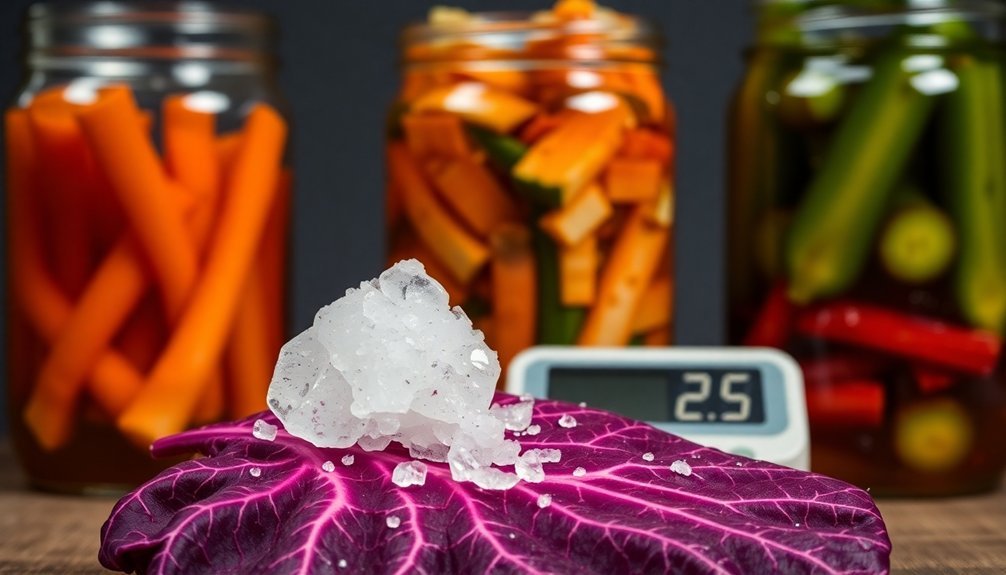
Finding your ideal salt percentage is a balancing act between fermentation speed, preservation, and taste preferences. While 2% salt concentration serves as a standard starting point, you'll want to adjust based on your specific vegetables and desired outcomes.
For most home ferments, you can follow these general guidelines to achieve excellent results:
- Start with 2-2.2% salt for basic vegetables like cabbage, carrots, and garlic – this provides enough preservation while allowing beneficial bacteria to thrive.
- Increase to 3-4% for water-rich vegetables like cucumbers and onions to maintain crispness and prevent spoilage.
- Use 5% or higher when you're aiming for extended shelf life or working in warmer temperatures that speed fermentation.
- Consider dropping to 1-2% only if you're using starter cultures or planning to consume your ferments quickly.
Remember that you can always adjust future batches based on your results. If your vegetables turn out too salty, try rinsing them before serving. If they're too soft, increase the salt percentage next time.
You'll need a digital scale for precise measurements, as accuracy matters when working with salt percentages.
Adjusting Salt for Different Seasons
Just as you master your preferred salt ratios, seasonal changes bring new factors to fermentation. You'll need to adjust your calculations because vegetables' water content varies greatly between seasons. For example, summer cabbages contain less water than their winter counterparts, which directly affects the final salt concentration in your ferments.
To maintain consistency across seasons, you'll want to use weight-based calculations rather than relying on volume measurements. Start by weighing both your vegetables and water, then multiply by your target salt percentage (typically 2-5%).
For water-rich vegetables that you'll dry salt, remember to account for their internal moisture when calculating. During summer, you might need to adjust slightly upward to compensate for lower water density.
If you're using a brine method, you can calculate based on the total volume of your jar, but you'll still need to take into account seasonal water content variations. Using a digital scale guarantees precision in your measurements.
When fermenting in warmer seasons, you might want to lean toward higher salt concentrations (3-5%) to control fermentation speed and prevent unwanted contamination.
Troubleshooting Salt Problems
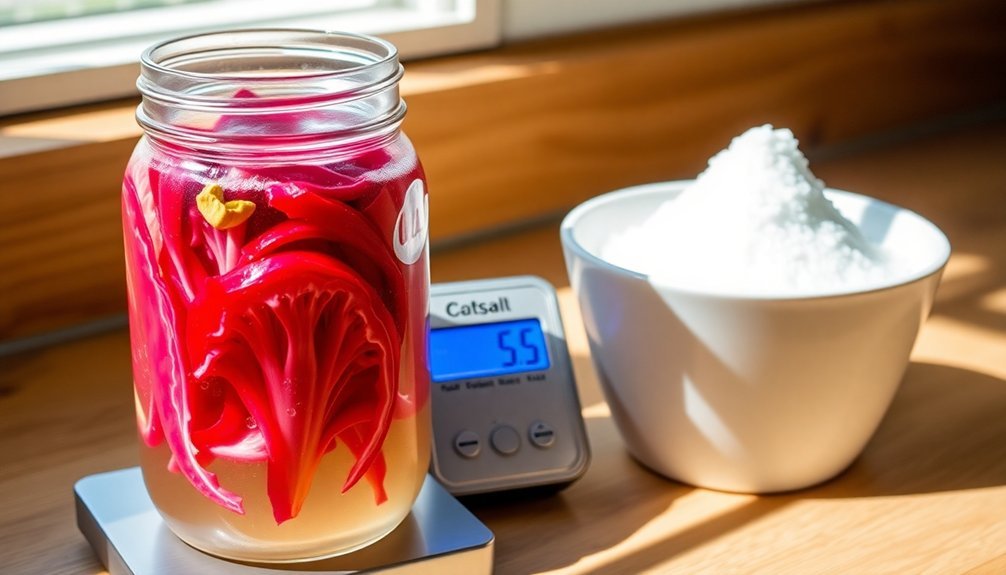
Every fermentation project can encounter salt-related challenges, but knowing how to identify and fix them will keep your vegetables safe and delicious. When you notice your ferment tastes excessively salty, don't panic – there are several effective solutions at your disposal.
If you've over-salted your ferment, you can take immediate corrective action. Try diluting the brine with additional water, mixing in fresh vegetables to balance the salt concentration, or pouring off some of the salty brine before adding fresh water.
In cases where the ferment is still too salty, you can use it as a flavoring ingredient in soups or stews.
To prevent salt issues in future ferments, follow these essential guidelines:
- Maintain a salt ratio between 1.5% and 3% of vegetable weight
- Use precise measurements rather than estimating
- Choose high-quality mineralized salt over processed varieties
- Monitor your ferment regularly and taste-test throughout the process
Remember that while salt is vital for fermentation, more isn't always better. Excessive salt can actually slow down fermentation and create an unfavorable environment for beneficial bacteria, ultimately affecting both the flavor and preservation of your vegetables.
Frequently Asked Questions
Can I Reuse Leftover Brine for New Ferments?
Yes, you can reuse leftover brine for new ferments. Just add 1/2 cup to a quart jar or 1 cup to a gallon jar, plus extra salt and water to cover your vegetables completely.
Does Altitude Affect Recommended Salt Percentages for Fermentation?
No, altitude doesn't affect the salt percentages you should use for fermentation. While altitude may influence fermentation speed and temperature considerations, you'll still want to stick to standard salt recommendations for your vegetables.
How Long Can Fermented Vegetables Last in Different Salt Concentrations?
You'll find that 1-2% salt ferments last weeks, 2-3% can go for months, and 3-5% ferments can keep for 6+ months. Higher salt concentrations preserve longer but may affect taste quality.
Should Salt Percentages Change When Combining Multiple Vegetables in One Ferment?
You don't need to adjust salt percentages when combining vegetables. Stick to a consistent 2-2.5% salt ratio for the total weight of mixed vegetables to guarantee successful fermentation and balanced preservation.
Does Using Iodized Salt Affect the Color of Fermented Vegetables?
You don't need to worry about iodized salt affecting your fermented vegetables' color. Research shows it won't impact the appearance, and you can safely use it while maintaining the same vibrant colors in your ferments.
In Summary
The perfect salt percentage for fermenting vegetables isn't a one-size-fits-all solution. You'll need to adjust between 2-5% based on your vegetables, climate, and taste preferences. Start with 2.5% for most vegetables and work your way up. Remember that you can't fix over-salted ferments, but you can always add more salt if needed. Trust your taste buds and keep notes on what works best for your ferments.





Leave a Reply